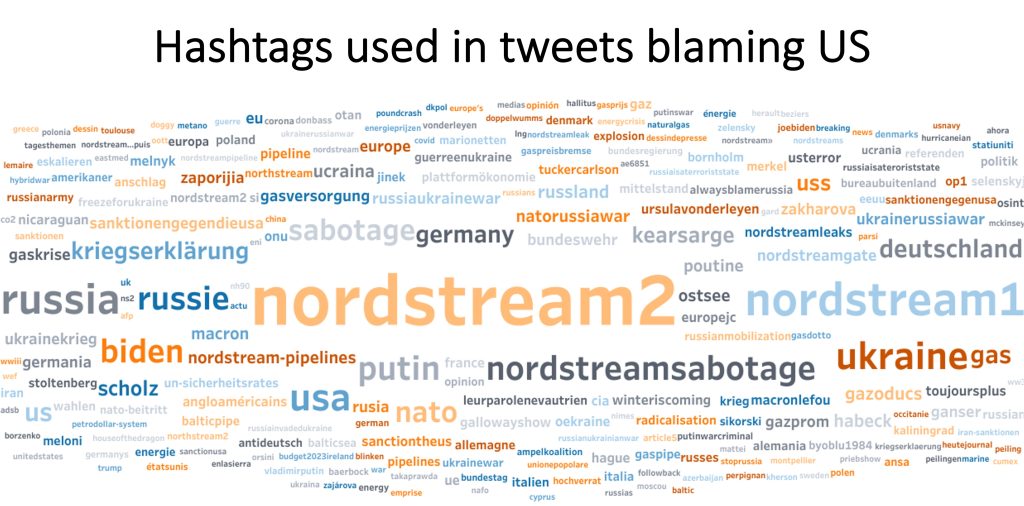It was a blatant falsehood: seven hours after the Nord Stream 2 pipeline reported a pressure drop, right-wing activist, conspiracy theorist, and former Donald Trump speechwriter Darren J. Beattie, blamed the CIA.
Other conspiracy theorists soon chimed in. Maram Susli tweeted a clip of President Biden saying, “there will be no longer a Nord Stream 2,” if Russia invades. Twitter users concluded that the United States was responsible for the sabotage. The next morning, French and German nationalist politicians and conservative pundits in the US added their voices. Only then did Chinese diplomats and the Ministry of Foreign Affairs of Russia regurgitate the claim.
The disinformation about US complicity gained traction. This case study used an open-source command line tool known as Twarc to archive nearly 500,000 tweets mentioning “nordstream” posted from September 24 to October 2. More than 63% blamed the US while 10% targeted Russia for the damaged pipelines. Only 27% of the posts remained neutral, asking users to wait until evidence is found before assigning responsibility or discussing the environmental impact of the escaped methane.

Twitter did not answer a request for comment on these findings.
These claims are not confined to Twitter. The same week, Facebook discovered a network of over 1,600 accounts targeting audiences in Germany, Italy, and France with pro-Russian propaganda. Disinformation surrounding the war in Ukraine often flows between other platforms like Telegram, Facebook, YouTube, and more. In addition to links to other tweets, posts also contained links to YouTube videos and Telegram channels perpetuating disinformation.
This case study demonstrates three pivotal lessons:
1. Disinformation launched in the US spreads fast to Europe, and vice versa, threatening the Atlantic Alliance.
Social media makes it easy for a message to reach a global audience. Craig Murray, whose self-reported location is in Scotland, posted the most retweeted claim within the data collection. He insisted that Ukraine, Poland, and the US “are trying to convince you it was Russia who blew it up” since the three nations were against the completion of Nord Stream 2. Overall, the top three self-reported locations of users perpetuating false Nord Stream claims were France, Germany, and the US.
The lie accusing the US soon morphed into criticism of the Atlantic Alliance. “Germany is not a sovereign country, but a vassal state,” multiple German tweets insisted. Others charged Norway, Poland, and Ukraine with a conspiracy, citing the Norway-Poland gas pipeline that opened on the same day as the Nord Stream leaks. “It’s all just one big coincidence, isn’t it?” one user insisted.
2. Extremist politicians and diplomats adopt disinformation that fits their own narratives and grievances.
French nationalist and far-right politician Florian Philippot tweeted about US responsibility eight times, calling on France to leave NATO and encouraging Berlin to see the sabotage as an act of war. German political members of Alternative für Deutschland such as Gunnar Lindemann began to weigh in, also insinuating Polish involvement in the sabotage and that, “the Poles earn from US fracking gas.”
In the US, podcasters, journalists, conservative pundits, and representatives for former GOP politicians began to speculate, often promoting conspiracies about the “deep state” and “inside jobs.” Like the lie about the US government using the COVID-19 pandemic to take away the rights of Americans, they suggested that Washington engineered the pipeline sabotage to manipulate Europeans, stating that, “the U.S. blew up Nordstream 2 in order to lock in Germany.”

3. The Kremlin leverages these fast-spreading lies spread by US citizens and Europeans.
Although disinformation did not originate from a Kremlin source, Russian actors exploit existing grievances and tensions within the West. The Ministry of Foreign Affairs of Russia waited until the online narrative about US sabotage had spread before weighing in. In the following days, the Russian Foreign Ministry featured the video clip of the White House Biden press conference comments on their English and Spanish profiles.
China soon became involved. Officials such as Zhang Meifang use Twitter to perpetuate claims that the US is at fault for the Nord Stream leak. He cited (in now-deleted tweets) Secretary Antony Blinken’s statement that this is, “a tremendous opportunity to remove the dependence on Russian energy.”

As the Nord Stream case shows, unsupported claims and outright lies spread fast online, picking up velocity and allowing anti-Western governments to pile on the disinformation. The root problem is not abroad. It starts at home.
Options for reforms remain far from obvious. Twitter recently rolled out a new crisis misinformation policy for conflict-related content. The platform, along with other social media outlets, now adds warning notices to tweets or reduces the visibility of accounts and tweets that violate its policy. This includes criteria like, “false allegations regarding use of force, incursions on territorial sovereignty, or around the use of weapons.”
Yet, these problematic Nord Stream posts remain on Twitter and elsewhere, without a warning notice or label. Many have reached hundreds of thousands, if not millions, of followers.
Mary Blankenship is a graduate student at the University of Nevada, Las Vegas, and an intern at CEPA’s Digital Innovation Initiative. Bill Echikson is the Acting Director of CEPA’s Digital Innovation Initiative and editor of Bandwidth.
Bandwidth is CEPA’s online journal dedicated to advancing transatlantic cooperation on tech policy. All opinions are those of the author and do not necessarily represent the position or views of the institutions they represent or the Center for European Policy Analysis.





